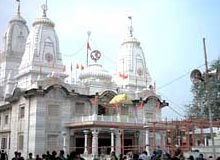Gorakhnath Math
| Gorakhnath Math | |
|---|---|
 Gorakhnath Temple | |
| Religion | |
| Affiliation | Hinduism |
| District | Gorakhpur |
| Deity | Shiva and Guru Gorakshanath |
| Festivals | Makar Sankranti |
| Location | |
| State | Uttar Pradesh |
| Country | India |
| Architecture | |
| Completed | unknown |
| Website | |
| gorakhnathmandir | |

The Gorakhnath Math, also known as Gorakhnath Temple or Shri Gorakhnath Mandir, is a temple of the
History
Gorakhpur takes its name from Gorakhnath, who was a saint of the 'Nath Sampradaya'. A shrine called Gorakhnath Mandir was built in his honour at the location where he did his Sādhanā.
The Gorakhpur region comprises the districts of Maharajganj, Kushinagar, Deoria, Azamgarh, Mau, Ballia and parts of Nepal Terai. These areas, which may be called the Gorakhpur Janapad, were an important centre of the Hindu culture.
Gorakhpur was a part of the
dynasties.The website of Gorakhnath Mandir describes its history and the attacks which the temple had to bear from time to time.[2]
Religious activity
Today's Gorakhnath Math, centred at Gorakhpur in eastern Uttar Pradesh (also named after the saint), is a religious institution that runs two Gorakhnath temples, one in Nepal in the district of Gorkha (another word believed to be derived from Baba Gorakhnath), and the other a little south of Gorakhpur. The temple at Gorakhpur is said to contain the samadhi shrine (transl. tomb) and gaddi (transl. prayer seat) of Gorakhnath. These temples constitute the centre of most of the Hindu religious activity in this region.
Thousands of devotees come to these temples on the occasion of
The Gorakhnath Math has a significant following in eastern Uttar Pradesh and the
The present

Within the Temple

The Gorakhnath temple is seen as the main
Mahants of Gorakhnath Math
- Yogi Naraharinath
- Gambhirnath
- Mahant Digvijay Nath
- Mahant Avaidyanath
- Yogi Adityanath
Political activity
The Gorakhnath Math has been involved in political matters for more than a century. Mahant
His successor,
In May 2015, the math organized special havans and kalash-yatra to pray for the victims of
Incidents
On 3 April 2022, a man named Ahmad Murtaza Abbasi was alleged to have tried to enter the temple premises forcibly and attacking police constables on duty.[10] and booked under the Unlawful Activities (Prevention) Act (UAPA).[11]
On 30 January 2023, 10 months after the attack Ahmad Murtaza was sentenced to death by a special NIA-ATS court in Lucknow, he was found guilty for waging war against country and murderous attack.[12]
References
- ^ Siddharth, Gautam (19 March 2017). "Uttar Pradesh CM: Math, that is hub of politics, has non-Brahmin priests". The Times of India. Retrieved 10 July 2020.
- ^ "History Of The Gorakhnath Temple - True Indology". True Indology. 12 April 2020. Retrieved 19 January 2023.
- ^ "This Muslim volunteer shares a special bond with Yogi Adityanath", Hindustan Times, 20 March 2017
- ^ ISBN 9781138095397.
- ^ a b
Indian Express. Retrieved 6 October 2014.
- ^ a b Apoorvanand (17 February 2007). "Riot, manufactured in Gorakhpur". Tehelka. Archived from the original on 4 March 2016. Retrieved 26 April 2007.
- ^ Asghar Ali Engineer (1–15 February 2006). "COMMUNAL RIOTS - 2005 (Part II): Major Riot in Mau (U.P.)". Archived from the original on 30 September 2007.
- ^ Atiq Khan (28 March 2007). "Yogi's revolt may hit BJP: Ex-BJP leader to go it alone in U.P". The Hindu. Archived from the original on 1 October 2007. Retrieved 26 April 2007.
- ^ "Gorakhnath Mutt temple holds havans and Kalashytra for 2015 Earthquake victims". news.biharprabha.com. ANI. 22 May 2015. Retrieved 22 May 2015.
- ^ Service, Tribune News. "IIT graduate attacks constables at Gorakhnath temple; ATS to probe". Tribuneindia News Service. Retrieved 5 April 2022.
- ^ "NIA may take over the probe into Gorakhnath temple attack: Officials". Hindustan Times. 17 April 2022. Retrieved 18 April 2022.
- ^ "Gorakhnath Temple Attacker Ahmed Murtaza Abbasi gets death penalty". The Times Of india. 30 January 2023. Retrieved 30 January 2023.
Further reading
- Dasgupta, Koushiki (5 July 2021). Sadhus in Indian Politics: Dynamics of Hindutva. SAGE Publishing India. ISBN 978-93-91370-95-4.
External links
